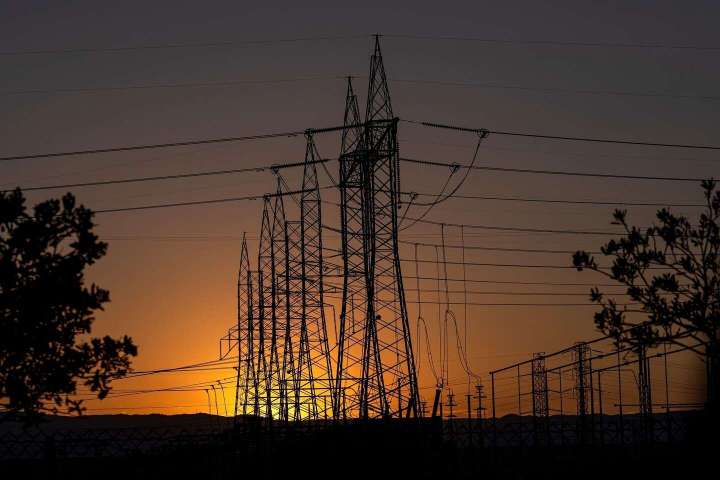Shortly after 5:15 p.m. Tuesday, California’s grid operator warned that the system was on the verge of rolling blackouts, thanks to a brutal heat wave that had everyone cranking up the air conditioning. Within half an hour, the state’s Office of Emergency Services had texted millions of California residents, urging them to turn off or reduce their nonessential power consumption. And just like that, the problem was solved: “Within five minutes,” reported Bloomberg, “the grid emergency was all but over.”
Can California’s electric-car mandate survive future heat waves?

This is the kind of stuff I lap up in these days of doom and gloom. Sure, climate change is creating a lot of problems, and so, frankly, is California’s troubled electricity infrastructure. But public-spirited citizens, with the aid of a little technological innovation, rose to the challenge! The glass is half full, not half empty, guys!
That said, I did wonder how that same scenario might play out a few years hence, as California’s electric-vehicle mandate kicks in. The state’s electric grid is already fragile and prone to blackouts. Two weeks ago, the California Air Resources Board approved an ambitious new plan to phase out the sale of gasoline-powered cars by 2035. Can California’s infrastructure hold up under the strain?
The state’s infrastructure is apparently already struggling with that problem. As Labor Day approached, the state’s beleaguered grid operator urged residents not to charge their electric vehicles between 4 and 9 p.m., when usage generally peaks. Yet at the moment, the state has only 563,070 electric vehicles — more than any other state, to be sure, but only about 3 percent of the nearly 18 million automobiles registered in California.
Follow Megan McArdle‘s opinions
FollowWhat happens when that figure is closer to 100 percent? It’s a relatively small thing for most people to put off doing laundry, turn off the lights in empty rooms or set the thermostat a few degrees higher. But using your car is not an optional activity in a state where virtually every town and city has been designed around the automobile. The government murmurs that by 2030 — when two-thirds of all new vehicles sold in the state are supposed to be electric — only 4 percent of the state’s electricity when use is highest will go to charging cars. But when loads are peaking, as they did on Tuesday, that might be 4 percent more than the state is currently capable of generating.
There are, of course, ways to mitigate the drain on the state’s overstretched grid. Ideally, everyone would charge their cars off solar panels during the day, when the sun is shining. For people who work from home, that might be a practical and thrifty solution. But even during the pandemic, most workers were employed in person, and few of those folks will be able to plug into a solar panel during working hours without a massive retrofit of the state’s garages and parking lots. And as long as the cost of public charging remains higher than the cost of charging at home, most people will probably wait until evening anyway.
Less drastically, people could use timers to start charging cars later in the evening, after everyone is in bed. But, of course, people could also put timers on their dryers and so forth; most of us do not, because the gadgets are fussy and inconvenient. To encourage that kind of behavior, California might need higher electricity prices — tricky, since the state already has some of the highest retail power costs in the nation. Alternatively, it could add a lot more generation and transmission capacity, which not only would help to hasten the future of all-electric cars but also would relieve the bottlenecks that are already pushing the state to the verge of blackouts during summer heat waves.
Unfortunately, energy abundance is often opposed by the people who ought to be its most ardent supporters.
California’s drive to zero-emissions vehicles is part of a broader plan to make the state carbon-neutral by 2045. That noble goal will increase electricity consumption as much as 68 percent, not only to charge electric vehicles but also to convert gas stoves to induction, gas furnaces to heat pumps, and gas dryers to electric, among the other changes that will be necessary for California to reach its target.
Unfortunately, California’s in-state electrical generating capacity has actually fallen since 2001. And environmental groups are pushing to reduce it further; when the state moved to extend the operating life of the Diablo Canyon nuclear plant — a reliable source of zero-emissions power even when the sun doesn’t shine and the wind doesn’t blow — legislators faced stiff opposition from environmental groups. (Fortunately, blackout-haunted legislators ignored them.)
Possibly, someday, California can power itself entirely on wind and solar. But the ideal can’t be the enemy of the real. If California wants people to run everything off electricity, the state can’t just decree it so; it needs to make it feasible, and attractive, so people will comply. That means power has to be extremely reliable and reasonably inexpensive. Which, in turn, means the state needs more than just high ideals and ambitious mandates; it needs to commit to building the generation and transmission capacity its vision will require.






